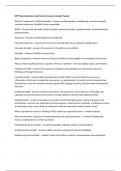NFPT Exam Questions and Correct Answers Already Passed
The Five Components of Physical Health - Answers cardiorespiratory conditioning, muscular strength,
muscular endurance, flexibility, body composition
SPICES - Answers Social Health, Physical Health, Intellectual Health, Cognitive Health, Emotional Health,
Spiritual Health
Endurance - Answers Cardiorespiratory Conditioning
Muscular Endurance - Answers The amount of strength that can be repeated multiple times
Muscular Strength - Answers The amount of strength in one repetition
Flexibility - Answers The ROM in given joints
Body Composition - Answers Amount of body fat relative to total weight or as compared to lean mass
What are three additional factors specific to fitness of athletes? - Answers Agility, Speed, and Mobility
Intellectual Health - Answers The capacity to integrate and assimilate new information into one's
thinking and thought processes
Cognitive Health - Answers Often grouped with mental health, has to do with how we process
information in the brain. Includes the way we see, or conceptualize, the world around. Includes brain
functioning in areas of conceptual and perceptual skill, language learning, and there brain development
functions.
Emotional Health - Answers Includes self-esteem, self-awareness, self-acceptance, self-image, and
capacities to deal with adversity and stress. Includes ability to intimate with significant other.
Spiritual Health - Answers Focused on connection of self with higher power. Sense of purpose, self-
actualization, and inner joy. Described as self-acceptance, repentance for misdeeds, a willingness to give
to and forgive others and a desire to seek peace with the community and the world overall.
Why is important to touch on all things SPICES related as a personal trainer? - Answers Explain.
What are the three categories of motivating factors for positive behavior? - Answers Predisposing
factors, enabling factors, reinforcing factors
Predisposing factors include? - Answers Knowledge, attitudes, beliefs, and perceptions
Enabling factors include? - Answers Skills, resources, physical and mental capabilities
Reinforcing factors include? - Answers Praise from others, rewards, encouragement and recognition
, Which factors does the PT usually fall into? - Answers Reinforcing factors. We can recognize how the
other two factors promote or inhibit positive behavior and we can work to reinforce positive behavior
with forms of encouragement.
What are some things that can be added to life to invoke positive change? - Answers Taking time for
meaningful reflection, reading a book, being creative, socializing with friends and family, adding physical
component and healthy eating to daily living.
What areas of exercise therapy would require a highly trained exercise physiologist or physician to
prescribe appropriate regimens? - Answers Cardiovascular disease, respiratory disease, joint injury, or
obesity/metabolic disorders which include diabetes and hypertension.
What is the purpose of muscles? - Answers To produce Force, maintain posture, allow for movement,
and produce heat.
All muscle action originates and is controlled by what? - Answers The brain, which sends and receives
signals through the nervous system.
What gets pulled during a muscle contraction? - Answers Tendons, the strong connective tissue that
connects muscles to bones.
What are the two points of muscle? - Answers Origin and Insertion
Define muscle origin. - Answers The origin is the point at which the muscle joins the stationary bone at
the end closest to the center of the body.
Define Muscle Insertion. - Answers The point at which the muscle joins ... When the muscle contracts
the insertion point moves toward the origin.
How many muscles in the average adult body? - Answers 656
TRUE OR FALSE: Muscles are joined together to form muscle groups to execute bodily movement. They
can get shorter and pull but they cannot push. - Answers True
TRUE OR FALSE: In muscle groups, when one group pulls the other group pulls back and as one team
pulls the other one relaxes. - Answers True
What are the three muscles types? - Answers Cardiac, Smooth, and Skeletal
What are the two subtypes of muscles? - Answers Involuntary and Voluntary
How many muscles are voluntary and how many bones do they control? - Answers 430 are voluntary,
controlling 206 bones.
Which type of muscles are voluntary? - Answers Skeletal muscles




